Birds of Prey
By Nick Siders
Some personal thoughts about birds of prey on how they live; how they hunt; and ideas on how to address the problems they give to pigeon breeders.
“In many cases there are “smart” ways to deal with these troubles. As a teen back in the 70’s I could leave my pigeons out all day long. For years growing up in the St. Louis Metro area I rarely even saw a hawk much less had an attack. Having rejoined the sport in the early 2000’s, I can hardly believe that the Coopers hawks of all hawks are so plentiful and that they are so efficient at what they do. In my area Goshawks are a rare winter visitor and now I truly pity the fanciers that live in areas where the Goshawk lives year round. The Coopers does not always make a kill, in fact only about 10% of the time here in MO. However, when the Goshawk attacks, so far their kill ratio has been 100 %.
I have found that pigeons have some natural friends in the bird world. I have a few Purple Martin houses and during the season that Martins are present, it is rare for any Coops to make their surprise ambush. My rollers understand the Martins distress / warning call and respond immediately by taking flight and going up high if a Coopers is culprit. Believe it or not, another avian friend to my rollers are the local Redtail Hawks (RTH). Coopers hawks are highly vulnerable when on the ground to attack with deadly intent by RTH. A RTH is highly unlikely to be successful in taking a roller. RTH’s are lazy and also have trouble doing the last minute maneuvers needed to actually make contact with a roller. Last winter I had a Coopers catch one of my rollers and carry to a nearby woods. Within 60 seconds two red-tailed hawks descended from out of no where and were searching for the Coopers that would have been struggling to kill the roller on the ground . My rollers have learned that the local Red Shouldered Hawks ( RSH ) are of nearly no threat to them. RSH are mousers mainly but have an inherit trait of mobbing any Coopers Hawk they see. So, another friend to my rollers. Bluejays, starlings, and many other small birds use a distinctive high pitched warning call for avian predators and a different call for ground based predators like cats, snakes or dogs. My rollers are out much more than the average roller mans birds with the idea that they learn some of these lessons in the summer before the winter BOP migrants arrive. Yeah, I loose some birds but then rollers are easy to raise, my breeders are prisoners, and I don’t mind raising more birds than I plan to keep. So far I have been able to afford the extra feed and have room for extra’s. What has astonished me is that some rollers that I raise with this intention should be culls but amazingly some turn out to be better than my selected “good pairs” . Doesn’t make sense but it happens every year so far.
I have discovered sort of a secret weapon here in MO. I have decided to video tape Hawks attacking my rollers. It is more difficult than it seems. And the best deterrent to Coopers attacks seem to be having a video cam in hand. The days I go outside with the cam, I hardly see a Coopers. The days I leave the camera inside are the days spectacular pursuits happen. Another irony but oddly enough seems true.”
My experience is limited to the Midwest and I have little encounters with the Northern Goshawk or with Falcons so my article would not pertain to those that live in different geographical area but I am sure many of us roller people live in Coopers type habitat like the Midwest and eastern US.
Another factor, fanciers should be aware of facts in the Midwest. Coopers hawk have breeding territories. Most nest are at least a mile from each other. Territories are well defended from intruding Coopers. That means most of us only have one pair of Coopers to deal with during the breeding season. Also, the male Coopers is substantially smaller than the female. It is much more difficult for a male to carry a roller to the nest. The female can easily carry a roller but the males can not easily lift them from the ground. Flying with a roller in tow could be a fatal mistake for a male Coopers that has to fly across an open area where the ever vigilant and always hungry RTH could make a meal out of both. Pigeon folks would be well advised to know that here in MO the Coopers leave the nest near the end of June. These newly fledged ( 2 to 6 ) hawks, will begin attacking anything that flies. I see this as a good thing for my rollers. A fledgling Coops has not acquired the stealth and surprise methods used by its seasoned parents. So a fledgling is likely to attack yes but it makes so many mistakes that rollers are not actually caught. Each time a flock of rollers is attacked and no kill is made the rollers learn. As the fledgling coopers get better so do the evasive tactics of my rollers not to mention the inborn fear of hawks is amplified. Coopers hawk do not hunt in packs and during the summer a fancier is dealing with one pair. An ideal time for rollers to learn. When fall comes, so do numerous migrating, near starving hawks. The rollers need every skill and a lot of luck in the winter. I do most of my flying in the winter now. Only if a persistent hawk hangs around do I ground my rollers for a few days. Another fact is that Coopers and all accipiters have a very fast metabolism. They can not wait around a week for a meal. After a few days of no kills they will move a better supply, more than likely, someone else’s loft. Another fact, over 80% of these newly fledged hawks will not survive to be one year old. A study in CA with RTH concluded that in five years, only one survived out of 100. So birds of prey do have a high mortality rate which leaves only the best to survive and breed.
Guess I should save my typing for an article but thought I would share some of my experience. I learn more as I go along and never consider that ” I have it all figured out ” but I do know shooting hawks even if it were legal will never solve the problems we now face. I think enlightened fanciers would fair better against hawks if they learned the nature of their local avian threat.” – Ted Glowczwski
============================================
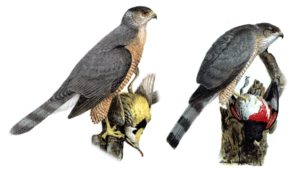
Cooper’s Hawk on the left and Sharp-shinned Hawk on the right. The Cooper’s Hawk appears to be a male by comparing the size against the Meadow Lark. The female is up to a third larger and can easily carry a Roller. The male cannot manage as well with carrying a Roller and often attempts to eat the kill instead of carrying it away. The Sharp-shinned Hawk is even smaller than the usual male Cooper’s Hawk and has some of the same difficulty in carrying its pigeon kill.
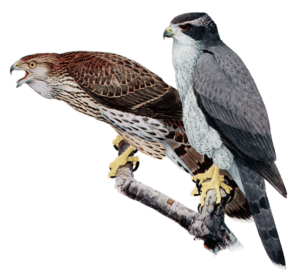
Goshawk. Youngster on left; adult on right. A very smart bird that has been watched walking around lofts and kit boxes looking for a way in. Once he understands he cannot get in he will wait nearby for the kit of birds to be liberated. The Goshawk kill ratio is exceptionally high as compared to the Cooper’s Hawk and the Goshawk can easily carry a pigeon kill.
Peregrine Falcon
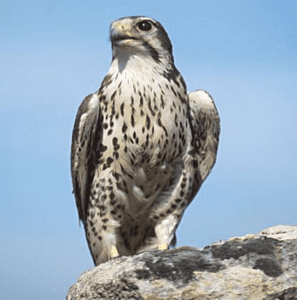
Prairie Falcon – It is felt by many that the Prairie Hawk is a natural hybrid that can reproduce.

The Peregrine Falcon is a great flier and is willing to rise up to the highest flying of kits to snatch a Roller. It is extremely fast and nimble; a very smart bird.
During migration time of the year some will see many more different kinds of birds of prey coming through their areas during those numbered days and will get hit by hawks and falcons they can’t readily identify without a guide. It goes without saying that these birds are beautiful and if it weren’t for the peril they place our beloved Rollers in we would delight having them around. As a breeder of pigeons one of the things you would dread most is to have a pair of Peregrine Falcons make a home nearby your loft.
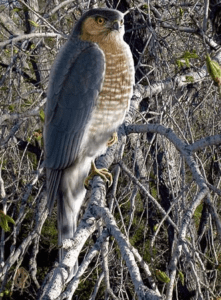

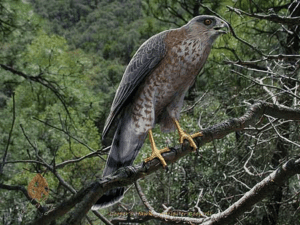
Unique Characteristics
The flight of accipiters is most distinctive. These hawks fly in a direct, purposeful way just at or a little below tree-top level, with four or five quick, sharp wing beats followed by a short glide. With an instinctive ability to be unobtrusive and unobserved, they reach their nests by flying low along the forest floor and then vertically up the nest tree to the nest. Of the three accipiters, the Northern Goshawk displays the heaviest and slowest wing beat. The distance the hawk will chase varies somewhat with circumstances, but generally the two smaller species seldom pursue a quarry for more than 100 m. The Northern Goshawk, a swifter and more persistent hunter, will press its attack on birds such as Ruffed Grouse, ptarmigan, and pheasant for as much as 1 km, particularly if the flight course is across open ground.
Accipiters can be distinguished from other types of hawks by their flight silhouettes (see sketch). Like the buteos (e.g., the Red-tailed Hawk Buteo jamaicensis) and harriers, the accipitrine hawks have rounded wings; however, these are shorter than in the other two groups. In contrast, the wings of another group of hawks, the falcons, such as the Kestrel or Sparrow Hawk Falco sparverius, are pointed.
============================================
A Closer Look at The Cooper’s Hawk
The male Cooper’s Hawk, sometimes assisted by the female, builds a platform nest of sticks and twigs from 20 to 60 feet above ground level in a tree located in a wooded area. From 4 to 6 eggs, incubated by the female, hatch in about 5 weeks. During this time, the male brings food to the female. After the eggs hatch, both parents tend the young who leave the nest after four to five weeks. Parents continue to provide food until the young become independent at about 8 weeks.
This bird prefers forest and shrub land areas and can also reside in urban areas or rural gardens. It has an estimated population of more than a 1,000,000 individuals. Because there are no signs of significant population decline, this bird does not qualify for inclusion on the IUCN Red List. Cooper’s Hawk currently has an evaluation level of Least Concern.
Length:
Males: 14-16 inches (37-41 cm)
Females: 16-19 inches (42-47 cm)
Wingspan:
Males: 28-30 inches (70-77 cm)
Females: 31-34 inches (79-87 cm)
Weight:
Males: 302-402 grams (10-14 oz)
Females: 479-678 grams (17-24 oz)
Raptors store food in a crop (pouch in the throat area). Food in the crop or stomach can effect the bird’s weight.
Diet: The diet of Coopers Hawks of birds (87% of prey numerically and 65% by biomass) and mammals (34% biomass) and 1% was prey other than birds or mammals.
Nest: Usually 18 – 28 inches in wide and 7-30 inches deep, with an inner cavity of 7 inches diameter and 2 – 4 inches deep. The nest is made of sticks and twigs. The nest cup is lined with chips or flakes of bark (from pine or oak) and sometimes fresh greenery.
The nest is usually placed on horizontal branches against the trunk of coniferous trees, or in the crotch of a deciduous tree 20-60 feet above the ground. About 50% of nests are 35-45 feet high.
Nest Construction usually begins in March or April.
Eggs: Clutch size is usually between 3-6 eggs.
Average size: 49 X 38.5 mm. Eggs are usually bluish or greenish white, then fade to dirty white. Eggs can be un-marked or have some brownish spots. Egg laying usually begins in early May to early June. Eggs are usually laid 30-48 hours apart.
Incubation period: Incubation may not start until most of the eggs are laid and is usually about 24 days. If incubation began after all the eggs were laid, then all chicks would hatch in 24 or 25 days. If incubation begins with the 3rd egg of a 4 egg clutch, then incubation would last an additional 1-2 days. If incubation begins with the 3rd egg of a 5 egg clutch, then incubation would last an additional 3-5 days for a total of 27-30 days.
The chicks usually hatch a few days apart.
Fledgling: Chicks usually begin “branching” from the nest before they can fly at about 28-30 days, but make their first flight between 32-36 days after hatching. Fledgling usually occurs between early July to early August.
Longevity Record: 20 Years and 4 months; based upon known age of a wild Cooper’s Hawk at banding and subsequent band recovery.
Migration: Cooper’s Hawks migrate from the Northern parts of the breeding range during late Autumn. There are many raptor migration sites where they can be viewed during Migration.
The Cooper’s Hawk return to the same breeding area year after year, but they build a new nest in a new site every year. The mated pair will stay together for the season but often change mates the following year.
The Cooper’s Hawk is often referred to as The Chicken Hawk. He’s not a popular bird with the farmers or pigeon breeders.
The hatching’s become fledglings around four weeks of age but return to the nest to be fed for another four weeks. The young reach breeding age the following year.
The Cooper’s Hawk was hunted extensively by farmers tired of the raids on their hen houses. The persecution did not have a lasting affect on their numbers. The number of Cooper’s Hawks in existence is stable.
During courtship displays, Cooper’s Hawk performs stylized flights with wings held in a deep arc. Male may fly around female, displaying its under tail coverts. It also raises the wings above its back, flying in wide circles with slow and rhythmic wing beats. These flight displays begin with pair soaring high on currents. First, male dives towards female, and follows her with a slow deep chase. Both birds fly with slow deep wing beats, interspersed with glides where white under tail coverts are spread.
Cooper’s Hawk is a territorial bird, defending its territory and nest site. The male will generally pluck and eat his kill of a pigeon at the kill site due to the problem he has in carrying the pigeon successfully. The female will carry the pigeon from the kill site to a plucking “pole” if they have young. It is usually located close to the nest and is a certain tree limb live or dead, but cleared enough to give quick access. If there are no young to be feed the female is likely to pluck and eat her fill at or near the kill site.
The pair are territorial and will protect there area from other BOP of a square mile. If you are receiving attacks on your feeders or pigeon loft it is more likely from that one pair and/or their young flying along with them. You could have 6, 7, or 8 individuals invading your sanctuaries and lofts at any given time with all of them being of the same family. There are times during the heavy migrating period before a territory is established by a residing pair that attacks will be from different individual Cooper’s Hawks as well as different breeds of BOP to include the Red Tail Hawk.
============================================
A Few Ideas For Avoiding Hawk Attacks
- Avoid flying at the same time every day.
This is almost impossible for the person who is employed, but if you want to survive through this problem of difficulty you have to change your times of liberation as often as you can. Some parts of the year you have a choice of a morning release or an evening release. If you can only fly on your days off take full advantage of the fact you can fly any time during the daylight hours of those precious days off.
- Be observant of your surroundings.
Look for the hawks that may be flying in your locale or perched on a launching spot. Know the prime areas for a hawk to wait in hiding for an ambush in your immediate area.
Is there an absents of wild birds? This may mean there is a hawk in the area and the wild birds are laying low hoping that the hawk will pass them up.
- Listen.
Be familiar with warning calls of all the species of birds that inhabit your area. That can be a sure sign that a hawk is nearby.
If there are no bird sounds that too could be an alert that the birds are laying low to avoid an attack and may be a sign that a bird of prey is near.
- Location of loft.
Loft should be located in an area that is open as possible giving your birds a long heads up of an oncoming hawk. You won’t avoid the attack, but you can help avoid the kill.
- Intermittent lock downs.
Sometimes short lock downs will push the hawk from your area if he is not residing there. I am talking about lock downs of 7 or ten days; maybe two weeks. If he cannot feed off of other birds in your loft’s area he can be induced to leave for better hunting grounds. Or make the decision not to homestead in your area.
In the flying of Roller Pigeons we have a ready made problem with hawks. Our birds will enter and exit the sky at the same location each and every time we fly them. Hawks who do reside a relatively long distance away will be able to observe a group of pigeons that does this and in just a day of two observing this will venture to take a look. Another way to avoid many attacks is to fly from a mobile loft. Most of us are not set up to be able to properly use a mobile loft. Those that compete may be hampered if he flies from a mobile loft. Historically few if any compete from a mobile loft.
In closing it is obvious that nothing will completely satisfy the problem. We will be losing birds to the hawks from here on out no matter what we do or don’t do. We just need to apply all the commonsensical systems we can to at least cut some of our loses by making sure we are not just flying into the “teeth” of the problem day after day after day. If you got the basketball in your hands just don’t keep driving to your left every time you move with it. The opposing team will begin to play you accordingly. Change up now and then and take it to your right.

